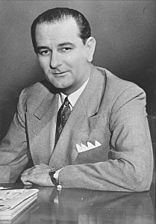November 6, 1956
(And other dates for special elections) 1958 → 17 15 2 2 Start date November 6, 1956 | 49 47 49 47 22,199,789 21,248,822 | |
 | ||
The United States Senate elections of 1956 (and subsequent special elections in 1957) were elections for the United States Senate that coincided with the re-election of President Dwight D. Eisenhower. Although the Democrats gained two seats in regular elections, the Republicans gained back two seats in special elections, leaving the party balance of the chamber remained unchanged.
Contents
Gains and losses
Democrats defeated incumbents Herman Welker (R-ID), George H. Bender (R-OH), and James H. Duff (R-PA), as well as winning a Republican-held seat in Colorado. Republicans defeated incumbent Earle C. Clements (D-KY) as well as winning Democratic-held seats in Kentucky, New York, and West Virginia.
Thus, this election caused Kentucky's U.S. Senate delegation to change from two Democrats to two Republicans.
Subsequent changes
During the next Congress, Republican John D. Hoblitzell, Jr. was appointed to the seat of deceased Senator Matthew M. Neely (D-WV), and Democrat William Proxmire won a special election to fill the vacancy created by the death of Senator Joseph R. McCarthy (R-WI). Also, Price Daniel (D-TX) left the Senate to become governor of Texas, and Democrat Ralph Yarborough won a special election for that Senate seat. The net result was to leave the party balance unchanged.
Results summary
For the November 1956 general and special elections.
Colored shading indicates party with largest share of that row.
Special elections during the 84th Congress
In these special elections, the winners were seated during 1956 or in 1957 before January 3; ordered by election date.
Races leading to the 85th Congress
In these general elections, the winners were elected for the term beginning January 3, 1956; ordered by state.
All of the elections involved the Class 3 seats.
Elections during the 85th Congress
In these elections, the winners were elected in 1957 after January 3; ordered by election date.
New York
In New York, the Republican state convention met on September 10 at Albany, New York, and nominated New York State Attorney General Jacob K. Javits. The Democratic state convention met on September 10 at Albany, New York, and nominated Mayor of New York City Robert F. Wagner, Jr., for the U.S. Senate. The Liberal Party endorsed the Democratic nominee, Mayor Robert F. Wagner, Jr., for the U.S. Senate. On October 1, a movement was launched to vote for General of the Army Douglas MacArthur as a write-in candidate for the U.S. Senate. On October 2, MacArthur disavowed the campaign, and stated that he was not a candidate.
The Republican candidate was elected.
North Dakota
In North Dakota, the incumbent, Republican Milton Young, sought and received re-election to his third term, defeating North Dakota Democratic-NPL Party candidate Quentin N. Burdick, son of North Dakota congressman Usher L. Burdick.
Only Young filed as a Republican, and the endorsed Democratic candidate was Quentin Burdick, the son of well-known politician Usher Burdick, and former candidate for Governor of North Dakota. Young and Burdick won the primary elections for their respective parties.
One independent candidate, Arthur C. Townley, also filed before the deadline. Townley would later seek the state's other senate seat in 1958 (see election), and was known for creating the National Non-Partisan League.
Oregon
In Oregon, Republican-turned-Independent-turned Democratic Senator Wayne Morse decided to seek re-election for his first full term as a Democrat. Morse defeated Republican candidate Douglas McKay in the hotly contested general election.
Pennsylvania
In Pennsylvania, incumbent Republican U.S. Senator James H. Duff sought re-election to another term, but was defeated by the Democratic nominee, Joseph S. Clark, Jr.
South Carolina
In South Carolina the regular election was held simultaneously with the special election.
The special election resulted from the resignation of Senator Strom Thurmond on April 4, 1956, who was keeping a campaign pledge he had made in the 1954 election. Thurmond was unopposed in his bid to complete the remaining four years of the term. Senator Strom Thurmond faced no opposition from South Carolina Democrats and avoided a primary election. There was a possibility that Governor George Bell Timmerman, Jr. might enter the race, but Thurmond was held in such high regard by the voters that there would have been no chance of defeating Thurmond. With no challenge to the remainder of the term, Thurmond did not conduct a campaign and rejoined his old law firm in Aiken until he returned to the Senate after the general election.
Incumbent Democratic Senator Olin D. Johnston handily defeated Republican mayor of Clemson Leon P. Crawford. Olin D. Johnston, the incumbent Senator, faced no opposition from South Carolina Democrats and avoided a primary election. Leon P. Crawford, the mayor of the town of Clemson in the Upstate, faced no opposition from South Carolina Republicans and avoided a primary election. Crawford campaigned as a defender of states' rights and denounced Johnston for backing the New Deal and the Fair Deal. The state Republican Party believed that Crawford could have a chance in the election if he galvanized the 128,000 registered black voters, although they were weary of being labeled as the black party. In the end, Johnston remained highly popular with the voters who were still leery of the Republican party and he easily defeated Crawford in the general election.
Vermont
In Vermont, incumbent Republican George Aiken ran successfully for re-election to another term in the United States Senate, defeating Democratic incumbent Bernard G. O'Shea.
